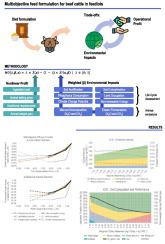Agricultural Systems ( IF 6.1 ) Pub Date : 2021-11-11 , DOI: 10.1016/j.agsy.2021.103308 J.G.O. Marques 1 , R. de Oliveira Silva 1 , L.G. Barioni 2 , J.A.J. Hall 3 , C. Fossaert 4 , L.O. Tedeschi 5 , F. Garcia-Launay 6 , D. Moran 1

|
CONTEXT
Reducing livestock greenhouse gas (GHG) emissions is now central to sustainable agricultural production strategies. Feedlot systems are a significant part of the production process in many countries, and associated feeding plans can influence product emission intensity significantly. Feed formulation can be used to target several objectives including animal productive performance, direct emissions from enteric fermentation and manure decomposition, and pre-farm gate emissions associated with the feed life cycles.
OBJECTIVE
To explore the environmental and economic trade-offs in feed formulation for beef cattle using multiobjective optimization.
METHODS
We develop a multiobjective model to derive the efficient frontier between profit maximization and environmental impact minimization in diet formulation for beef cattle in a typical French feedlot system. The nonlinear profit function includes animal performance, animal selling price, and feeding costs. The environmental impact accounts for the feed ingredient life cycles (non-renewable energy consumption, phosphorus demand, soil acidification, soil eutrophication, climate change potential, and land requirement), and for methane and nitrous oxide emissions from enteric fermentation and manure decomposition. The model is solved using a combination of optimization methods and for two scenarios with different weights representing the environmental impacts: a low carbon scenario (minimizing only CO2eq emissions), and a balanced impacts scenario (minimizing the sum of impacts with an arbitrary choice of weights derived from the literature).
RESULTS AND CONCLUSIONS
We show that optimal cost-effective mitigation arises from a combined strategy, concurrently: increasing animal performance by 20% and reducing daily emissions from the feed life cycle by 50% and from enteric fermentation and manure decomposition emissions by 43%. With this strategy, both scenarios present similar maximum GHG reduction in the feedlot phase – around 42% compared to the maximum-profit solution. The similar behaviour of both scenarios shows that environmental impact transference only occurs in more extreme solutions. Finally, about 50% of the total potential reduction can be achieved at a cost of 22 € / kg CO2eq / kg CWE.
SIGNIFICANCE
Results suggest that significant GHG emissions reduction can be obtained solely from manipulating animal diets. Achieving these reductions cost-effectively derives from a combination of well-known strategies rather than focusing on any one individually.
中文翻译:

使用多目标优化评估牛饲料策略中的环境和经济权衡
语境
减少牲畜温室气体 (GHG) 排放现在是可持续农业生产战略的核心。饲养场系统是许多国家生产过程的重要组成部分,相关的饲养计划会显着影响产品排放强度。饲料配方可用于实现多个目标,包括动物生产性能、肠道发酵和粪便分解的直接排放,以及与饲料生命周期相关的农场前排放。
客观的
使用多目标优化探索肉牛饲料配方的环境和经济权衡。
方法
我们开发了一个多目标模型,以推导出典型法国饲养场系统中肉牛日粮配方中利润最大化和环境影响最小化之间的有效边界。非线性利润函数包括动物性能、动物售价和饲养成本。环境影响包括饲料原料生命周期(不可再生能源消耗、磷需求、土壤酸化、土壤富营养化、气候变化潜力和土地需求),以及肠道发酵和粪便分解产生的甲烷和一氧化二氮排放。该模型使用优化方法的组合以及代表环境影响的不同权重的两种情景求解:低碳情景(仅将 CO 2eq 排放)和平衡影响情景(通过从文献中任意选择权重来最小化影响总和)。
结果和结论
我们表明,最佳的成本效益缓解来自组合策略,同时:将动物性能提高 20%,将饲料生命周期中的每日排放量减少 50%,将肠道发酵和粪便分解排放量减少 43%。使用这种策略,两种情况在饲养场阶段都呈现出类似的最大温室气体减少量——与最大利润解决方案相比,减少了约 42%。两种情景的相似行为表明,环境影响转移只发生在更极端的解决方案中。最后,以 22 € / kg CO 2 eq / kg CWE的成本可以实现总潜在减排量的约 50% 。
意义
结果表明,仅通过操纵动物饮食就可以显着减少温室气体排放。以成本有效的方式实现这些减少来自于众所周知的策略的组合,而不是单独关注任何一个。











































 京公网安备 11010802027423号
京公网安备 11010802027423号